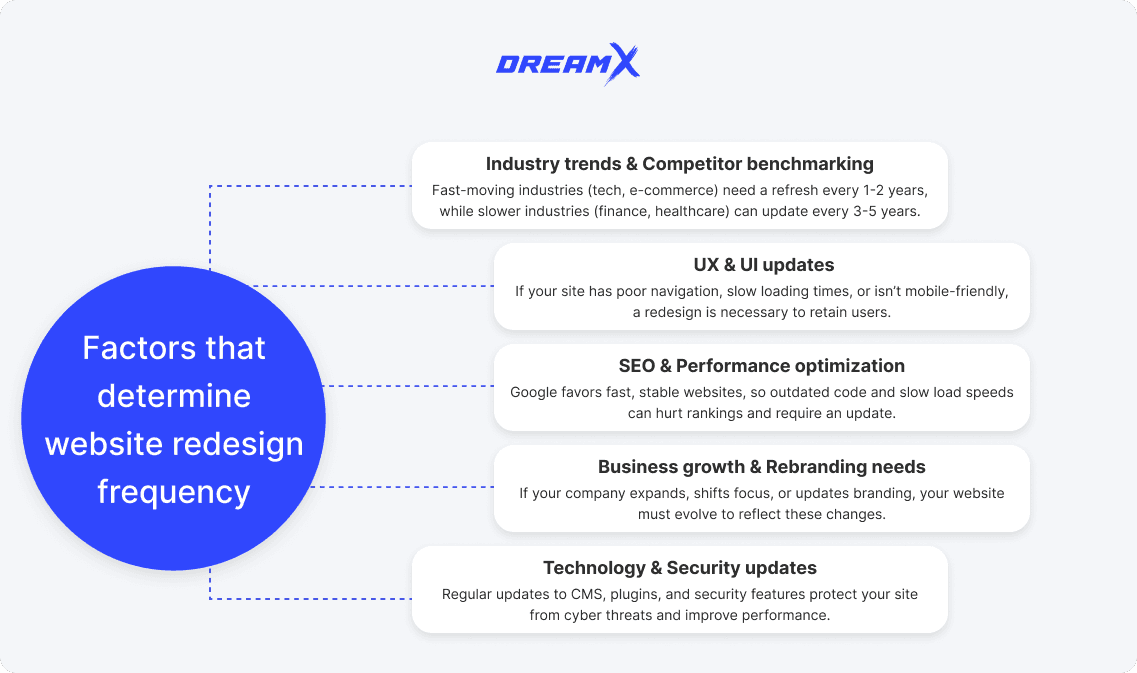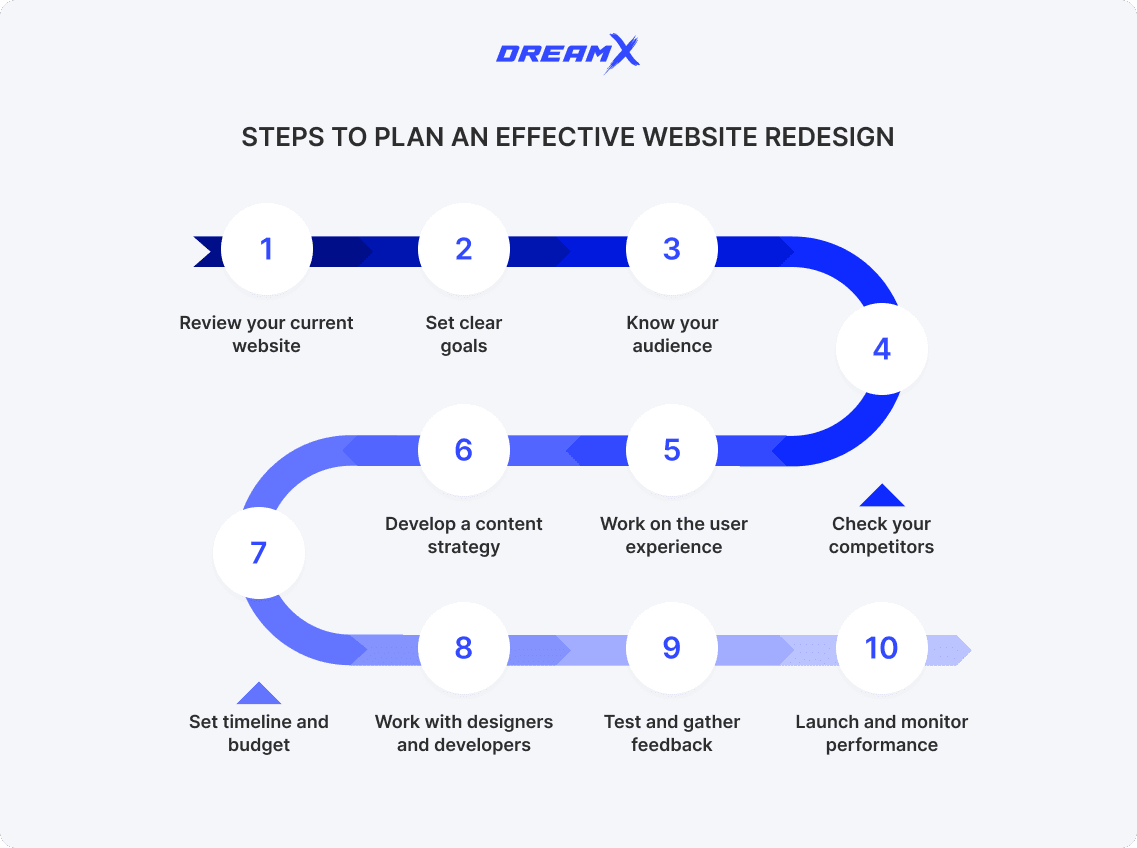Modern users do not think twice when they land on your website. Studies show that people assess your website in just a few seconds. If it doesn't load quickly, isn't visually appealing, or lacks clear navigation, they simply leave. It’s absolutely true. Just ask yourself – what websites do you like? The ones which provide a smooth, engaging experience, right? But you may further wonder - how do I know when it’s time to redesign my website? In this article, we’ll highlight the signs that it’s time for a website makeover and share expert tips to keep your site a step ahead of competitors.
Factors that determine website redesign frequency
Your website is the heart of your brand online and the first thing potential customers see. Technology, user expectations, and business goals continuously evolve. Step in the shoes of an average user and open any website. Now, keep track of how long it takes before you lose interest and move on to another resource. Milliseconds! It’s not an exaggeration – studies show nearly 40% of visitors will leave your site just because of outdated design.
So, here is a logical question: when is it time to redesign your website? The truth is, there's no single answer. Some experts suggest a major redesign every 2-3 years, and others recommend small updates regularly. The best approach depends on factors like your business, industry, and audience. Let’s review these in more detail!

Industry trends & Competitor benchmarking
New design trends appear every day and user expectations grow, and you can’t ignore these if you want to remain competitive. If you are in e-commerce and technology, you should update your website every 1-2 years. These sectors are fast-moving, and customers demand fresh, relevant content and designs. On the other hand, healthcare, finance, and manufacturing are slower-moving industries. Companies from these spheres can update their websites every 2-5 years.
How do you know when redesign website? Conduct an audit of your top competitors’ sites at least twice a year. Make a list of changes, new features, or design improvements they have made. The competitor analysis will reveal elements that your website doesn’t have. If you see some - it’s a sign for a refresh. Website maintenance is knowing what competitors are doing and being a step ahead of them.
Learn from others:
Website redesign frequency differs from industry to industry. For example, tech and SaaS companies often need a refresh every one to two years to keep pace with innovation. E-commerce businesses typically update their websites every two to three years to stay competitive and maximize conversions. In healthcare, finance, and manufacturing, redesign cycles range from three to five years, ensuring compliance, security, and industry relevance.
User Experience (UX) & Interface (UI) updates
If your site's navigation is confusing, your forms are tedious, or your content is difficult to read on mobile devices, you are surely losing potential customers. Modern UX means intuitive navigation, streamlined forms, and mobile responsiveness. Conduct regular usability testing and gather user feedback. Analyze website analytics to identify pain points and areas for user experience improvements. High bounce rates, low conversion and increased customer service inquiries are red flags; it’s time to redesign your website.
Learn from others:
Amazon redesigned its homepage. The focus is on personalized product recommendations and an improved browsing experience. Key changes include a "Window Display" for custom content, streamlined navigation, and a faster repeat-purchase process with the "Buy Again" hub. These UI/UX updates boost sales.
SEO & Performance optimization
Google's emphasis on Core Web Vitals (loading speed, interactivity, visual stability) has made performance optimization a critical aspect of SEO. If your site is slow, it will negatively impact your search rankings and user experience. Also, outdated HTML or poor mobile optimization can hinder your SEO impact of redesign. Before a full redesign for SEO, conduct a technical SEO audit to spot any website performance issues. Often, small targeted changes can improve your site's performance without the need for a complete website redesign.
Learn from others:
A good example is the CNN website. Today, the company’s content dominates news searches. However, the company invested a lot in its SEO strategy – they added captions, transcripts, and SEO-friendly titles to their video content. Also, the site is fully responsive and accessible from all devices.
Business growth & Rebranding needs
As your business grows, you need branding and design refresh. If you have added new products, changed your audience, or rebranded, it’s time for website be redesigned. An outdated site can confuse customers and weaken your brand message. Review your brand to see if your website matches your message, audience, and goals. Make sure visuals, tone, and content truly convey your brand identity. A content management system will help you with trouble-free CMS updates.
Learn from others:
In 2018, Mailchimp shifted from email marketing to a full marketing platform. It redesigned its logo, adopted a bold yellow color scheme, introduced quirky illustrations, and updated typography for a cohesive look. This redesign website project increased engagement by 200%!
Technology & Security updates
Old tech and weak security can put your website at risk. For example, outdated CMS platforms or plugins can make your site vulnerable to hackers and cause compatibility problems. To keep your site safe, update your software regularly and follow security best practices. You should follow the latest web development trends and security standards. Regularly update your CMS, plugins, and themes. Also, implement SSL certificates and security best practices to protect your website from cyber threats.
Learn from others:
WordPress is powered by PHP. However, websites that use PHP 7.4 become more vulnerable to security threats, including hacking attempts, malware infections, and data breaches. So, WordPress recommends website owners upgrade to PHP 8.0 or newer.
Recommended timeframes for website redesign
There’s no universal rule for how often you should update your website, but here are some general guidelines:
Minor updates (every 6-12 months). Small updates will keep your website fresh and functional. This includes refreshing content strategy and SEO and site speed optimization. Additionally, pay attention to fixing broken links and updating images.
Moderate redesign (every 2-3 years). Your website should offer what users demand. You must update layouts, improve navigation, and add new features. These steps keep your site visually appealing and easy to use without a complete overhaul.
Major redesign (every 4-5 years). Sometimes, a full rebuild is necessary to keep up with technological advancements. A major redesign often reworks the entire structure, design, and technology stack, and you need to hire experts in website redesign services for this.
Steps to plan an effective website redesign
When redesign website you don’t make it look better. The task is to improve its functionality, user experience, and performance. Here’s how to plan an effective redesign:

Review your current website. Determine what’s working and what’s not. Look at the design, navigation, load speed, and overall UX. Identify areas that you want to improve.
Set clear goals. Ask yourself – Why do I redesign my website? It can be better engagement, higher conversions, or new features.
Know your audience. Take time to understand what your users like, dislike and how they behave to know what design elements will best meet their expectations.
Check your competitors. Look at what makes their websites popular. Take notes on design trends, functionality, and user experience, but also find ways to differentiate your site.
Work on the user experience (UX). Make your website easy to use. A user-friendly site keeps visitors engaged and guides them through their buying journeys.
Develop a content strategy. Upgrade your content, and think about launching a blog. A redesign is the perfect time to attract new readers and turn them into customers.
Set timeline and budget. Break the project into phases, set deadlines, and plan cost for website redesign.
Work with experts. You can do many things on your own. However, professional designers, developers, and content creators will guarantee a polished, high-quality end result.
Test and gather feedback. Test your new website with real users before the launch. Identify any issues and refine the design based on this feedback.
Launch and monitor performance. Shortly after you go live, track traffic, bounce rates, and conversions. A website is never truly finished – you should continuously optimize it.
Final thoughts
A website redesign is an ongoing process. The best companies treat their websites like valuable assets that need regular updates and improvements. The general recommendation is to redesign a website every 2-3 years, but the right timing depends on your needs and feel. Don’t wait until users lose interest - track key metrics and plan ahead. This strategic approach will help you stay competitive.
Still have questions? Don’t hesitate to reach out to DreamX! We are a team of professional designers with expertise in website design in many industries. Let us boost your website performance with top-notch design!
When is it time to redesign your website? Warning signs
Veronika Ovchynnykova
Team Lead UX/UI Designer

Veronika is a UX/UI design team lead driven by a passion for user-centric design. She spearheads the creation of innovative and effective design solutions that elevate the user experience.






